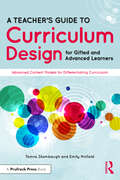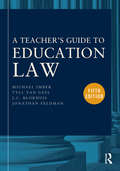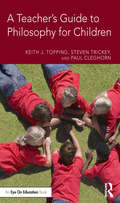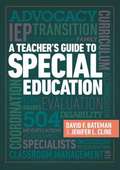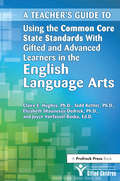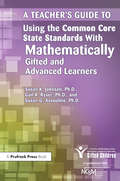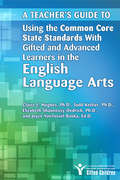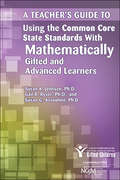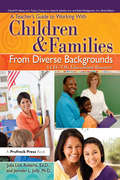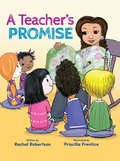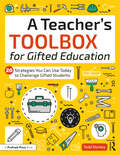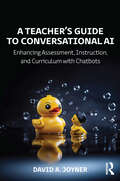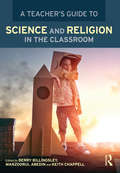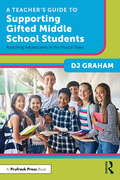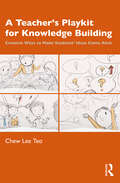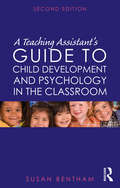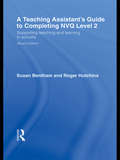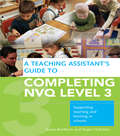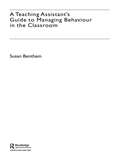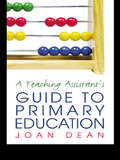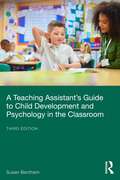- Table View
- List View
A Teacher's Guide to Curriculum Design for Gifted and Advanced Learners: Advanced Content Models for Differentiating Curriculum
by Tamra Stambaugh Emily MofieldA Teacher’s Guide to Curriculum Design for Gifted and Advanced Learners provides educators with models and strategies they can easily use to create appropriately complex differentiated lessons, questions, tasks, and projects. This must-have resource for both gifted and regular education teachers: Includes specific thinking models for teaching English language arts, social studies, and STEM. Is ideal for teachers who are looking for ways to differentiate and design lessons for their highest achieving students. Provides multiple examples of how to embed complexity within standards-based lessons. Highlights units and models from Vanderbilt University's Programs for Talented Youth curriculum. Helps teachers provide the necessary challenge for advanced learners to thrive. The models have been vetted by content experts in the relevant disciplines and were designed to guide students to develop expertise within a discipline. Definitions of widely used terms, such as depth, complexity, and abstractness, are explained and linked to models within specific content areas to support common understanding and application of schoolwide differentiation strategies.
A Teacher's Guide to Education Law
by Tyll Van Geel Michael Imber Jonathan Feldman J. C. BlokhuisAdapted from its parent volume Education Law, 5th Edition, this accessible text concisely introduces topics in law that are most relevant to teachers. Providing public school teachers with the legal knowledge necessary to do their jobs, A Teacher’s Guide to Education Law covers issues of student rights, discipline, negligence, discrimination, special education, teacher rights, hiring and firing, contracts, unions, collective bargaining, and tenure. Special Features: This revised edition includes new content on bullying, privacy, discrimination, school finance, and issues relating to Internet and technology, as well as updated references and case law throughout. To aid comprehension, technical terms are carefully explained and summaries of key topics and principles are provided. Case law is presented within the context of real-world examples, making this text accessible to pre-service teachers who have little background in law. A companion website provides additional resources for students and instructors, such as links to full cases and a glossary of key concepts.
A Teacher's Guide to Philosophy for Children
by Keith J. Topping Steven Trickey Paul CleghornA Teacher’s Guide to Philosophy for Children provides educators with the process and structures to engage children in inquiring as a group into ‘big’ moral, ethical and spiritual questions, while also considering curricular necessities and the demands of national and local standards. Based on the actual experiences of educators in diverse and global classroom contexts, this comprehensive guide gives you the tools you need to introduce philosophical thinking into your classroom, curriculum and beyond. Drawing on research-based educational and psychological models, this book highlights the advantages gained by students who regularly participate in philosophical discussion: from building cognitive and social/emotional development, to becoming more informed citizens. Helpful tools and supplementary online resources offer additional frameworks for supporting and sustaining a higher level of thinking and problem-solving among your students. This practical guide is essential reading for teachers, coaches and anyone wondering how you can effectively teach philosophy in your classroom.
A Teacher's Guide to Special Education
by David Bateman Jenifer ClineDespite the prevalence of students with disabilities in the general education classroom, few teachers receive training on how to meet these students' needs or how to navigate Despite the prevalence of students with disabilities in the general education classroom, few teachers receive training on how to meet these students' needs or how to navigate the legally mandated processes enumerated in the Individuals with Disabilities Education Act (IDEA). What is their role? What are their responsibilities? What are the roles and rights of parents? And what must all teachers do to ensure that students with disabilities and other special needs receive the quality education they're entitled to? In this practical reference, David F. Bateman--bestselling author of A Principal's Guide to Special Education --and special education administrator Jenifer L. Cline clarify what general education teachers need to know about special education law and processes and provide a guide to instructional best practices for the inclusive classroom. Topics covered include The pre-referral, referral, and evaluation processes Individualized education programs (IEPs) and the parties involved Accommodations for students who do not quality for special education, including those covered by Section 504 Transition from preK to K-12 and from high school to postschool life Classroom management and student behavior Educational frameworks, instructional strategies, and service delivery options Assessment, grades, graduation, and diplomas The breadth of coverage in this book, along with its practical examples, action steps, and appendixes covering key terms and definitions will provide the foundation all K-12 teachers need to successfully instruct and support students receiving special education services. It's an indispensable resource for every general education classroom. the legally mandated processes enumerated in the Individuals with Disabilities Education Act (IDEA). What is their role? What are their responsibilities? What are the roles and rights of parents? And what must all teachers do to ensure that students with disabilities and other special needs receive the quality education they're entitled to? In this practical reference, David F. Bateman--bestselling author of A Principal's Guide to Special Education --and special education administrator Jenifer L. Cline clarify what general education teachers need to know about special education law and processes and provide a guide to instructional best practices for the inclusive classroom. Topics covered include The pre-referral, referral, and evaluation processes Individualized education programs (IEPs) and the parties involved Accommodations for students who do not quality for special education, including those covered by Section 504 Transition from preK to K-12 and from high school to postschool life Classroom management and student behavior Educational frameworks, instructional strategies, and service delivery options Assessment, grades, graduation, and diplomas The breadth of coverage in this book, along with its practical examples, action steps, and appendixes covering key terms and definitions will provide the foundation all K-12 teachers need to successfully instruct and support students receiving special education services. It's an indispensable resource for every general education classroom.
A Teacher's Guide to Using the Common Core State Standards With Gifted and Advanced Learners in the English/Language Arts
by Elizabeth Shaunessy-Dedrick Todd Kettler National Assoc For Gifted ChildrenA Teacher's Guide to Using the Common Core State Standards With Gifted and Advanced Learners in the English/Language Arts provides teachers and administrators a blueprint for differentiating the Common Core State Standards for English Language Arts for gifted and advanced students through the use of acceleration, depth, complexity, and creativity within and across grade levels. It illustrates the differences between learning experiences for typical and advanced students based on the same standard and provides an array of examples across five of the information text and literary text standards while integrating the other aspects of language arts teaching and learning. The book highlights implementation features, such as classroom management and assessment of student work, that allow teachers to make data-based decisions about instruction for particular students. It also offers guidance to teachers on reading selections for advanced learners at all grade levels.
A Teacher's Guide to Using the Common Core State Standards With Mathematically Gifted and Advanced Learners
by Susan Assouline National Assoc For Gifted Children Gail R. RyserA Teacher's Guide to Using the Common Core State Standards in Mathematics provides teachers and administrators with practical examples of ways to build a comprehensive, coherent, and continuous set of learning experiences for gifted and advanced students. It describes informal, traditional, off-level, and 21st century math assessments that are useful in making educational decisions about placement and programming. Featuring learning experiences for each grade within one math progression, the book offers insight into useful ways of both accelerating and enriching the CCSS mathematics standards. Each of the learning experiences includes a sequence of activities, implementation examples, and formative assessments. Specific instructional and management strategies for implementing the standards within the classroom, school, and school district will be helpful for both K-12 teachers and administrators.
A Teacher's Guide to Using the Common Core State Standards with Gifted and Advanced Learners in the English/Language Arts
by Joyce Vantassel-Baska Elizabeth Shaunessy-Dedrick Claire Hughes Todd KettlerA Teacher's Guide to Using the Common Core State Standards With Gifted and Advanced Learners in the English/Language Arts provides teachers and administrators a blueprint for differentiating the Common Core State Standards for English Language Arts for gifted and advanced students through the use of acceleration, depth, complexity, and creativity within and across grade levels. It illustrates the differences between learning experiences for typical and advanced students based on the same standard and provides an array of examples across five of the information text and literary text standards while integrating the other aspects of language arts teaching and learning. The book highlights implementation features, such as classroom management and assessment of student work, that allow teachers to make data-based decisions about instruction for particular students. It also offers guidance to teachers on reading selections for advanced learners at all grade levels.
A Teacher's Guide to Using the Common Core State Standards with Mathematically Gifted and Advanced Learners
by Gail Ryser Susan Assouline Susan JohnsenA Teacher's Guide to Using the Common Core State Standards With Mathematically Gifted and Advanced Learners provides teachers and administrators with practical examples of ways to build a comprehensive, coherent, and continuous set of learning experiences for gifted and advanced students. It describes informal, traditional, off-level, and 21st century math assessments that are useful in making educational decisions about placement and programming. Featuring learning experiences for each grade within one math progression, the book offers insight into useful ways of both accelerating and enriching the CCSS mathematics standards. Each of the learning experiences includes a sequence of activities, implementation examples, and formative assessments. Specific instructional and management strategies for implementing the standards within the classroom, school, and school district will be helpful for both K-12 teachers and administrators.
A Teacher's Guide to Using the Next Generation Science Standards with Gifted and Advanced Learners
by Cheryll Adams Alicia Cotabish Debbie DaileyA Teacher's Guide to Using the Next Generation Science Standards With Gifted and Advanced Learners provides teachers and administrators with practical examples of ways to build comprehensive, coherent, and rigorous science learning experiences for gifted and advanced students from kindergarten to high school. It provides an array of examples across the four domains of science: physical sciences; Earth and space sciences; life sciences; and engineering, technology, and applications of science. Each learning experience indicates the performance expectation addressed and includes a sequence of activities, implementation examples, connections to the CCSS-Math and CCSS-ELA, and formative assessments. Chapters on specific instructional and management strategies, assessment, and professional development suggestions for implementing the standards within the classroom will be helpful for both teachers and administrators.
A Teacher's Guide to Working With Children and Families From Diverse Backgrounds: A CEC-TAG Educational Resource
by Jennifer Jolly Julia Link RobertsSchools are increasingly diverse in their student population, presenting new challenges for teachers. In light of these challenges, schools remain important in the talent development process. A Teacher's Guide to Working With Children and Families From Diverse Backgrounds provides important information and strategies for educators at all levels. The book is written for educators who want all children to thrive in school, including those who are twice-exceptional, those from lower income backgrounds, and others who have been underrepresented in gifted programming.
A Teacher's Guide to Writing Workshop Essentials: Time, Choice, Response
by Katherine Bomer Corinne Arens*How can I get started with writing workshop, or refine my workshop? *What are the essential elements of a writing workshop? *How can I create daily structures and routines that support writers? In this foundational guide, Katherine Bomer and Corinne Arens describe the elegant simplicity of a Writing Workshop focused on just three essentials―time, choice, and response. Based on the research-based belief that children learn to write best when we provide a predictable, daily structure for writing, Katherine and Corinne introduce teachers to the rituals and routines of writing workshop and suggest ways to take small, incremental steps toward implementing them. Shared from the viewpoint of two veteran educators who understand the issues and obstacles teachers face day to day, A Teacher’s Guide to Writing Workshop Essentials also serves as a refresher for experienced workshop teachers looking for a chance to refocus, clarify, and extend the work in their practice. If your teaching has become more complicated and more focused on curriculum than on the writers sitting in front of you, if you’re not sure what your students really need to support them as writers, or if you’re just not sure how to get started with Writing Workshop, this guide is for you.
A Teacher's Promise
by Rachel Robertson Priscilla PrenticeIn every classroom, there is a person who cares about the way children learn, grow, and feel--the teacher! <P><P>The affirming verses and fanciful illustrations in A Teacher's Promise express what all teachers wish for the children they teach--that they develop self-confidence, perseverance, curiosity, and an enjoyment of learning. This book can help ease fears children might have about joining a new classroom or child care setting.Rachel Robertson is vice president of learning and development at Bright Horizons.Priscilla Prentice is also the illustrator of When You Just Have to Roar!
A Teacher's Toolbox for Gifted Education: 20 Strategies You Can Use Today to Challenge Gifted Students
by Todd StanleyThis book provides busy teachers with an adaptable toolbox of strategies for challenging gifted students that they can immediately put into practice in their classroom, school, or program. Chapters cover everything from makerspaces and project-based learning, to enrichment clubs, mentorships, creative thinking, and more. Each strategy includes an overview, resource guide, description of how it looks in the classroom, and all the information you need to put it into practice. With templates, charts, and links to videos illustrating the tools in action, A Teacher’s Toolbox for Gifted Education is your go-to guide for creative ways to support advanced learners.
A Teachers' Guide to the Special Educational Needs of Blind and Visually Handicapped Children
by Sally S. MangoldSuggestions and ideas from educational officials on how to provide additional support to blind students in the classroom setting.
A Teacher’s Guide to Conversational AI: Enhancing Assessment, Instruction, and Curriculum with Chatbots
by David A. JoynerA Teacher’s Guide to Conversational AI explores the practical role that language-based artificial intelligence tools play in classroom teaching, learning experiences, and student assessment. Today’s educators are well aware that conversational and generative AI—chatbots, intelligent tutoring systems, large language models, and more—represent a complex new factor in teaching and learning. This introductory primer offers comprehensive, novice-friendly guidance into the challenges and opportunities of incorporating AI into K-12 schools and college classes in ways that are appropriate, nourishing to students, and outcomes-driven.Opening with an informative overview of the foundational properties, key terminology, and ethical considerations of these tools, the book offers a coherent and realistic vision of classrooms that are enhanced, rather than stymied, by AI systems. This includes strategies for:· designing assessments that are conducive to students’ beneficial use of AI while mitigating overreliance or dishonesty;· using AI to generate lesson examples for student critique or custom content that reinforces course principles;· leveraging chatbots as a co-instructor or a tutor, a guide during student-driven learning, a virtual debate or brainstorming partner, and a design project; and· creating course content, lesson plans and activities, expanded language and accessibility options, and beyond. Through the depth of understanding and applied approach provided in these chapters, teachers and leaders in training and in service, alongside private tutors, college instructors, and other educators, will be better prepared to future-proof their efforts to serve new generations of learners.
A Teacher’s Guide to Science and Religion in the Classroom
by Berry Billingsley Manzoorul Abedin Keith ChappellA Teacher’s Guide to Science and Religion in the Classroom provides practical guidance on how to help children access positive ways of thinking about the relationship between science and religion. Written for teachers of children from diverse-faith and non-faith backgrounds, it explores key concepts, identifies gaps and common misconceptions in children’s knowledge, and offers advice on how to help them form a deeper understanding of both science and religion. Drawing on the latest research as well as the designs of successful workshops for teachers and for children, there are activities in each chapter that have been shown to help children understand why science and religion do not necessarily conflict. The book highlights children’s interest in the so-called "Big Questions" that bridge science and religion and responds to the research finding that most children are missing ideas that are key to an explanation of why science and religion can be harmonious. The book explores key concepts and ideas including: Nature of science Power and limits of science Evolution, genes and human improvement Miracles, natural disasters and mystery Profiles of scientists, including Galileo and Newton A Teacher’s Guide to Science and Religion is an essential companion for preservice and practising teachers, providing session plans and pedagogic strategies, together with a cohesive framework, that will support teachers in fostering children’s curiosity and enthusiasm for learning.
A Teacher’s Guide to Supporting Gifted Middle School Students: Reaching Adolescents in the Pivotal Years
by DJ GrahamA Teacher’s Guide to Supporting Gifted Middle School Students provides insight to help you gain a better understanding of your gifted students during a pivotal time in their development. Employing pop culture, personal stories, and prompts for reflection, this text considers major factors impacting gifted middle school students including self-image, the need for differentiated content, the importance of slowing down, the value of mentors, and ways to instill hope during this ‒ more often than not ‒ difficult time. Full of practical examples for how you can work to address both the academic and social-emotional needs of your students, this book champions middle school as an important time for selfdiscovery and developing passions. Engaging and informative, this inspiring new book is a “must read” for all teachers seeking to positively influence their students during this unique and critical time in their lives.
A Teacher’s Playkit for Knowledge Building: Creative Ways to Make Students’ Ideas Come Alive
by Chew Lee TeoDelving into the journey of teachers and students in the knowledge building classroom, Teo’s playkit offers practical approaches to making classrooms a place of knowledge creation. Teo highlights the potential and possibility of idea-centric discourse and interactions in Singapore’s high-performing education system while offering a trilogue among researchers, teachers and students: the agents of a knowledge building environment in classrooms. Documenting case examples of knowledge building lessons in relation to the curriculum design and pedagogical decisions and moves, as well as the formative assessment, the book focuses on those 21st-century practices embedded within the knowledge building process. It comprises a series of teachers’ journeys in different subjects and grades, demonstrating the depth and breadth of projects that students are capable of pursuing in class when they are entrusted to work with their own ideas and questions. It also offers a collection of concrete tools and strategies for teachers to use to support knowledge building work. The different case examples support teachers in their design effort and will encourage the community of researchers and educators to continue to imagine the possibilities of pedagogical educational reform. Written for practitioners, this playkit aims to engage the wider community of teachers to play with their own lesson ideas as they engage their students in knowledge creation.
A Teacher’s Playkit for Knowledge Building: Creative Ways to Make Students’ Ideas Come Alive
by Chew Lee TeoDelving into the journey of teachers and students in the knowledge building classroom, Teo’s playkit offers practical approaches to making classrooms a place of knowledge creation.Teo highlights the potential and possibility of idea-centric discourse and interactions in Singapore’s high-performing education system while offering a trilogue among researchers, teachers and students: the agents of a knowledge building environment in classrooms. Documenting case examples of knowledge building lessons in relation to the curriculum design and pedagogical decisions and moves, as well as the formative assessment, the book focuses on those 21st-century practices embedded within the knowledge building process. It comprises a series of teachers’ journeys in different subjects and grades, demonstrating the depth and breadth of projects that students are capable of pursuing in class when they are entrusted to work with their own ideas and questions. It also offers a collection of concrete tools and strategies for teachers to use to support knowledge building work. The different case examples support teachers in their design effort and will encourage the community of researchers and educators to continue to imagine the possibilities of pedagogical educational reform.Written for practitioners, this playkit aims to engage the wider community of teachers to play with their own lesson ideas as they engage their students in knowledge creation.
A Teaching Assistant's Guide to Child Development and Psychology in the Classroom: Second edition
by Susan BenthamHow can you help students most effectively in the classroom? As a Teaching Assistant, you play a vital role in today’s schools. This fully updated new edition will help you get to grips with the main issues to do with psychology and its role in the processes of teaching and learning. This accessible text, building on the success of a best-selling previous edition, provides informative, yet down-to-earth commentary with clear examples of how you can apply this knowledge in everyday practice. The book addresses issues including: how to support learning how to identify and cater for different learning styles teaching children with additional needs how to manage behaviour to support learning how to help children with their self-esteem and independence. This new edition includes references to up-to-date research in child development and psychology to include information regarding personalised learning, creativity, motivation, friendships skills, moral development and neuroscience. Chapters are complemented with lively case studies, self-assessment questions and examples of how to apply theory to everyday classroom practice. The reader is encouraged to develop reflective practice to best support childrens’ behaviour and learning. This reader-friendly book is an invaluable companion for every Teaching assistant, HLTA, Cover Supervisor, and anyone working in a supporting role in an educational setting.
A Teaching Assistant's Guide to Completing NVQ Level 2: Supporting Teaching and Learning in Schools
by Susan Bentham Roger HutchinsBased on the updated National Occupational Standards for Supporting Teaching and Learning in Schools, this new edition of A Teaching Assistant’s Guide to Completing NVQ Level 2 caters directly to the criteria of the course, providing the necessary ‘Knowledge and Understanding’ required as well as invaluable information regarding evidence collection. Incorporating the changed guidelines regarding evidence collection this comprehensive guide demonstrates the role of the assessor in observing and questioning the candidate and that of the candidate asking colleagues to provide witness statements. As well as providing in-depth underpinning knowledge for all mandatory units and a vast array of optional units, this book offers a range of tried-and-tested materials and practical advice for NVQ Level 2 candidates. The authors have included numerous self-assessment activities, case studies and quizzes to enable candidates to check their understanding of key concepts, to make connections from theory to practice and to assist them in their observation and assessment sessions. Written in an engaging and approachable manner and illustrated with many cartoons, this book aims to give the candidate the knowledge necessary to embark on this qualification with confidence. A wide range of chapters provides essential advice for NVQ Level 2 candidates, including how to: support children’s development; provide effective support for your colleagues; observe and report on pupil performance; provide support for learning activities; support a child with disabilities or special educational needs. Highly practical and rooted in everyday classroom practice, this book is specifically aimed at teaching assistants enrolled on, or embarking upon, NVQ courses that support the government’s National Occupational Standards. In addition this book will be of benefit to schools and teachers who are supporting teaching assistants taking this course.
A Teaching Assistant's Guide to Completing NVQ Level 3: Supporting Teaching and Learning in Schools
by Susan Bentham Roger HutchinsA Teaching Assistant's Guide to Completing NVQ Level 3 is a must-have for all teaching assistants embarking on this course, and invaluable reading for tutors and assessors. This textbook addresses both the performance and knowledge requirements of the course. A key element of your NVQ Teaching Assistant course is to show evidence that you can apply your knowledge to everyday classroom activities, and students often find this is their biggest challenge. This book provides a range of tried-and-tested materials and practical advice on how to gather evidence that covers key performance indicators, to ensure that you complete your course successfully. This essential guide: gives detailed guidance on how to collect evidence from a variety of sources to match performance indicators provides photocopiable templates for teacher/teaching assistant discussions on roles and responsibilities, appraisals and self-appraisals gives examples of IEPs and Behaviour Plans provides the necessary underpinning knowledge in a clear and reader-friendly manner provides summaries of relevant legislation and national documents. Following the new and updated occupational standards (2007) for Supporting Teaching and Learning in Schools, this textbook offers truly invaluable advice for NVQ level 3 students. Including extracts of imaginary evidence the book follows the experiences of imaginary candidates, showing how they successfully put forward their portfolios of evidence to complete the course. Highly practical, rooted in everyday classroom practice and very closely tied to NVQ course requirements, this accessible book is an essential comprehensive guide for all students, as well as tutors, assessors and teachers supporting candidates for this course.
A Teaching Assistant's Guide to Managing Behaviour in the Classroom
by Susan BenthamA practical and authoritative guide to common behaviour problems in the classroom, this book explaines typical causes of misbehaviour and shows what teaching assistants can do to calm disruptive children. Using a range of case studies discussed from a teaching assistant's perspective, Susan Bentham explores: the role of the teaching assistant in relation to school behaviour policies when and how to reward good behaviour why we need to understand the reason for bad behaviour in order to deal with it how to implement behaviour strategies that really work. Mirroring the course content of most teaching assistant GNVQ and Foundation degree qualifications, Bentham highlights how practitioners can learn from their experiences and develop new skills and coping strategies, which will free them up to concentrate on the most important part of the job: supporting learning. In an expanding market, this guide is a must-buy for any teaching assistant finding that disrupted classrooms are becoming their biggest challenge.
A Teaching Assistant's Guide to Primary Education
by Joan DeanThis jargon-free book has been specially written for teaching assistants taking up posts in primary schools working at NVQ Level 2 and 3 of the National Occupational Standards of Teaching Assistants. It covers every area of primary education, including: an overview of primary education the qualities, knowledge and skills needed the curriculum managing behaviour evaluation and record-keeping professional development. Joan Dean knows primary education inside out and is well known in the field. She uses case studies based on real life scenarios to provide a detailed yet accessible book, making it essential reading for teaching assistants. This guide will also offer support and advice to staff working with teaching assistants and to those who provide their training.
A Teaching Assistant’s Guide to Child Development and Psychology in the Classroom
by Susan BenthamHow can you help students most effectively in the classroom? As a teaching assistant, you play a vital role in today’s schools. This fully updated third edition will help you get to grips with the main issues to do with psychology and its role in the processes of teaching and learning.This accessible text provides informative, yet down-to-earth commentary with clear examples of how you can apply this knowledge in everyday practice. This book addresses issues such as how to support learning and behaviour, how to create an optimal learning environment for all students, ways to encourage pupil voice, supportive strategies for children with additional needs, and how to help children with their self-esteem and independence. This new edition includes references to up-to-date research in child development and psychology to include information regarding wellbeing, mental health, and learning strategies related to insights from cognitive science. Chapters are complemented with lively case studies, self-assessment questions, and examples of how to apply theory to everyday classroom practice. The reader is encouraged to develop reflective practice to best support children’s behaviour and learning.This reader-friendly book is an invaluable companion for every teaching assistant, HLTA, pastoral support assistant, learning mentor, classroom cover supervisor and anyone working in a supporting role in an educational setting.
